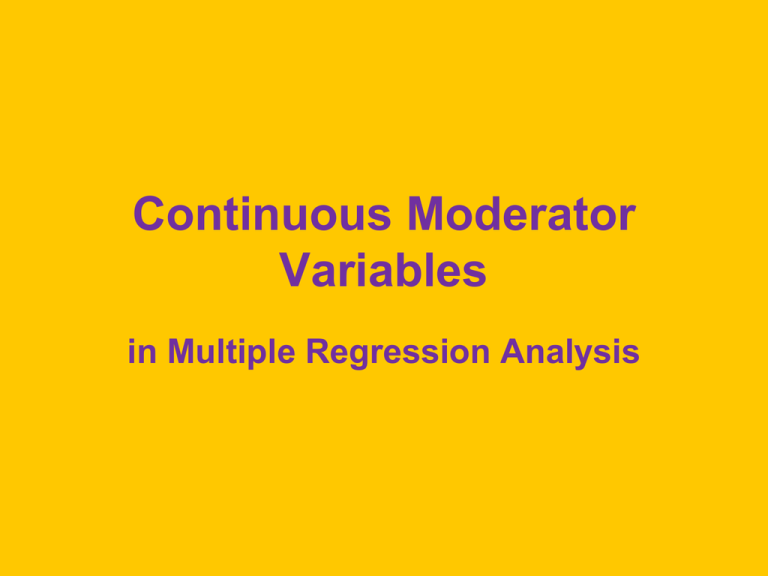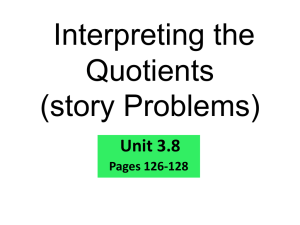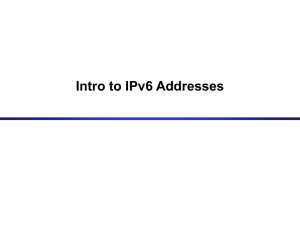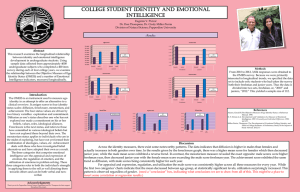Moderation Models
advertisement

Continuous Moderator Variables in Multiple Regression Analysis What is a Moderator? • A variable that alters the relationship between two or more other variables. • If the relationship between X and Y varies across levels of M, then M is a moderator. • “Moderation” is nothing more than what we called “interaction” in factorial ANOVA Misanthropy, Idealism, and Attitudes About Animals • Same data I used to illustrate a Potthoff analysis. • But idealism will not be dichotomized. • The criterion variable is score on the first subscale of the Animal Attitudes scale. – The Animal Rights subscale – 12 Likert-type items – Cronbach alpha = .87. Download • Moderate.dat from my data files page. • Moderate.sas from my SAS programs page. • Point the program to the data file. • Run the program. Center the Variables ? • Subtract mean from each score – For all predictor variables that are involved in the interaction(s) • This is commonly done and believed to prevent problems with – Multicollinearity – And other things (see Howell) • May center the outcome variable too, but that is not necessary. Don’t Center the Variables • As recently demonstrated by Andrew Hayes, it is NOT necessary to center the predictors. • It may, however, be easier to interpret the results if they are centered. Standardize the Variables • Unstandardized regression coefficients are rarely useful for the psychologist. • Just standardize all of the variables to z scores. – Which, of course, are centered. – proc standard mean=0 std=1 out=Zs; Create the Interaction Term(s) & Run the Regression • • • • data Interaction; set Zs; Interact = Misanth*Ideal; proc corr; var AR Misanth Ideal Interact; proc reg; model AR = Misanth Ideal interact / stb tol; run; Regression Output • R2 = .113 , p < .001 • ZAR = .303ZMisanth + .067ZIdeal .153Zinteract • The interaction is significant, p = .049. • What does the regression look like for low (-1), medium (0), and high (+1) values of the moderator? Idealism = Low (-1) • • • • Substitute (-1) for ZIdeal .303 ZMisanth + .067(-1) + (-.153)(-1) ZMisanth ZAR = .456 ZMisanth - .067 AR increases by .456 SD for each one SD increase in Misanth • Now, watch this simple slope decrease as we increase idealism. Idealism = Medium (0) or High (+1) • Medium Idealism 303 ZMisanth + .067(0) + .153(0) Zmisanth • ZAR = . 303 ZMisanth • High Idealism • .303 ZMisanth + .067(1) + (-.153)(1) ZMisanth • ZAR = .15 ZMisanth + .067 Find 2 Points for Each Line • Low Idealism: ZAR = .456 ZMisanth - .067 • Low Idealism, Low Misanthropy: ZAR = .456(-1) -.067 = -.523 • Low Idealism, High Misanthropy: ZAR = .456(+1) - .067 = .389 • Mean Idealism: ZAR = . 303 ZMisanth • Mean Idealism, Low Misanthropy: ZAR = .303(-1) = -.303 • Mean Idealism, High Misanthropy: ZAR = .303(+1) = .303 • High Idealism: ZAR = .15 ZMisanth + .067 • High Idealism, Low Misanthropy: ZAR = .15(-1) + .067 = -.083 • High Idealism, High Misanthropy: ZAR = .15(+1) + .067 = .217 Plot the Three Lines Use Italassi It Comes with Data Click the Equations Tab • • • • You get Y predicted from X1 Y predicted from X2 Y predicted from X1 and X2 Y predicted from X1 and X2 and the interaction term Click on the 2-D View Tab • Select the predictor variable to display on the abscissa. • Select “Multiple with interaction.” • Move the slider to change the value of the moderator variable. Click on the Variables Tab • Enter these values • Dependent = AR • Independent X1 = Misanthropy – Minimum = -1.97 – Maximum = 2.5 • Independent X2 = Idealism – Minimum = -2.54 – Maximum = 2.54 Click on the Equations Tab • Enter the parameters for the interaction model. Click on the 2-D Tab • Model: Multiple with interaction • Misanthropy on the abscissa. • Move the slider to vary the level of idealism. Process Hayes • Hayes, A. F. (2013). Introduction to mediation, moderation, and conditional process analysis. New York, NY: Guilford. • Highly recommended for those into mediation, moderation, and moderated mediation (aka conditional process analysis). Process Hayes • Hayes provides SAS and SPSS macros that make it much easier to conduct these analyses. • Download the macros, data files, etc. • The first step is to identify the model that matches the analysis you wish to do. • Run Process.sas. • If the data are not already in SAS, bring them in. Moderate_Process.sas %process (data=Zs,vars=AR Misanth Ideal, y=ar,x=Misanth,m=Ideal,model=1,jn=1,plot=1); Model Summary R R-sq F df1 df2 p 0.3362 0.1130 6.3721 3.0000 150.0000 0.0004 Model coeff constant -0.0202 IDEAL 0.0672 MISANTH 0.3028 INT_1 -0.1456 INT_1 se 0.0773 0.0777 0.0777 0.0733 t -0.2615 0.8643 3.8990 -1.9861 p 0.7940 0.3888 0.0001 0.0488 LLCI -0.1730 -0.0864 0.1494 -0.2905 ULCI 0.1326 0.2207 0.4563 -0.0007 R-square increase due to interaction(s): R2-chng F df1 df2 p 0.0233 3.9446 1.0000 150.0000 0.0488 The Simple Slopes Conditional effect of X on Y at values of the moderator(s) IDEAL Effect se t p LLCI ULCI -1.0000 0.4485 0.1074 4.1738 0.0001 0.2361 0.6608 -0.0000 1.0000 0.3028 0.1572 0.0777 0.1062 3.8990 1.4803 0.0001 0.1494 0.1409 -0.0526 Values for “Effect” here are the standardized simple slopes at three levels of standardized Idealism. 0.4563 0.3670 Johnson-Neyman Technique Moderator values(s) defining Johnson-Neyman significance region(s) Value % below % above 0.7788 77.2727 22.7273 Misanthropy is significantly correlated with support for animal rights when the standardized value of idealism is .77 or lower. Predicted Values of zar Data for visualizing conditional effect of X on Y MISANTH IDEAL yhat -1.0000 -1.0000 -0.5358 -0.0000 -1.0000 -0.0874 1.0000 -1.0000 0.3611 -1.0000 -0.0000 -0.3230 -0.0000 -0.0000 -0.0202 1.0000 -0.0000 0.2826 -1.0000 1.0000 -0.1102 -0.0000 1.0000 0.0469 1.0000 1.0000 0.2041 Data for Plot of Simple Slopes data plot; input Misanthropy Idealism Animal_Rights; cards; -1.0000 -0.0000 1.0000 -1.0000 -0.0000 1.0000 -1.0000 -0.0000 1.0000 -1.0000 -1.0000 -1.0000 -0.0000 -0.0000 -0.0000 1.0000 1.0000 1.0000 -0.5358 -0.0874 0.3611 -0.3230 -0.0202 0.2826 -0.1102 0.0469 0.2041 Code for Plot of Simple Slopes proc sgplot; reg x = misanthropy y = Animal_Rights / group = Idealism nomarkers; yaxis label='Standardized Support of Animal Rights'; xaxis label='Standardized Misanthropy'; run; Plot of Simple Slopes Table of Conditional Effects Conditional effect of X on Y at values of the moderator (M) IDEAL Effect se t p LLCI ULCI -2.0275 0.5981 0.1686 3.5483 0.0005 0.2650 0.9312 -1.0140 0.4505 0.1082 4.1651 0.0001 0.2368 0.6642 0.7597 0.1922 0.0950 2.0220 0.0450 0.0044 0.3800 0.7788 0.1894 0.0959 1.9759 0.0500 0.0000 0.3788 1.0131 0.1553 0.1068 1.4533 0.1482 -0.0558 0.3664 2.0267 0.0076 0.1669 0.0458 0.9635 -0.3221 0.3374 I have trimmed this table a lot, so it would fit on this slide. 2 Leftmost & 2 Rightmost Cols data plot_JN; input Idealism Effect llci ulci; cards; -2.0275 0.5981 0.2650 0.9312 -1.0140 0.4505 0.2368 0.6642 0.7788 0.1894 0.0000 0.3788 1.0131 0.1553 -0.0558 0.3664 I have trimmed out most of the rows here to make this fit on this slide. Code for Johnson-Neyman Plot proc sgplot; series x=Idealism y=ulci/curvelabel = '95% Upper Limit' linesattr=(color=red pattern=ShortDash); series x=Idealism y=effect/curvelabel = 'Point Estimate' linesattr=(color=blue pattern=Solid); series x=Idealism y=llci/curvelabel = '95% Lower Limit' linesattr=(color=red pattern=ShortDash); xaxis label = 'Idealism'; yaxis label = 'Conditional effect of misanthropy'; refline 0/axis=y transparency=0.5; refline .7788/axis=x transparency=0.5; run; Johnson-Neyman Plot








